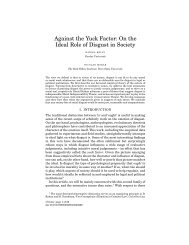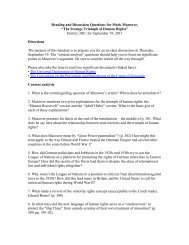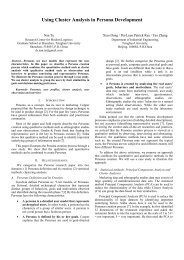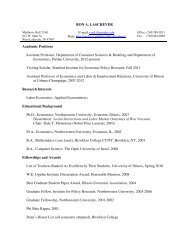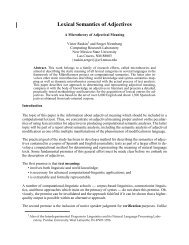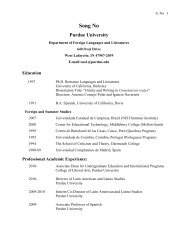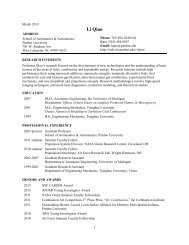Parsons 1942 - Career Account Web Pages
Parsons 1942 - Career Account Web Pages
Parsons 1942 - Career Account Web Pages
Create successful ePaper yourself
Turn your PDF publications into a flip-book with our unique Google optimized e-Paper software.
Age and Sex in the Social Structure of the United States<br />
Author(s): Talcott <strong>Parsons</strong><br />
Source: American Sociological Review, Vol. 7, No. 5 (Oct., <strong>1942</strong>), pp. 604-616<br />
Published by: American Sociological Association<br />
Stable URL: http://www.jstor.org/stable/2085686 .<br />
Accessed: 13/11/2013 17:34<br />
Your use of the JSTOR archive indicates your acceptance of the Terms & Conditions of Use, available at .<br />
http://www.jstor.org/page/info/about/policies/terms.jsp<br />
.<br />
JSTOR is a not-for-profit service that helps scholars, researchers, and students discover, use, and build upon a wide range of<br />
content in a trusted digital archive. We use information technology and tools to increase productivity and facilitate new forms<br />
of scholarship. For more information about JSTOR, please contact support@jstor.org.<br />
.<br />
American Sociological Association is collaborating with JSTOR to digitize, preserve and extend access to<br />
American Sociological Review.<br />
http://www.jstor.org<br />
This content downloaded from 128.210.126.199 on Wed, 13 Nov 2013 17:34:48 PM<br />
All use subject to JSTOR Terms and Conditions
J<br />
AGE AND SEX IN THE SOCIAL STRUCTURE<br />
OF THE UNITED STATES*<br />
TALCOTT PARSONS<br />
Harvard University<br />
Points of interest. Male, female, and youth cultures in our society.<br />
Significance of the "swell guy" and "glamor girl." The isolation of<br />
old age in America. German versus American youth cultures. Adult<br />
male specialization versus the "common human" values of youth. The<br />
domestic, the glamorous, and the good-companion roles of women.<br />
Are sex roles becoming more alike or unlike? Sex roles and the<br />
difficulty of maintaining companionship in modern marriage. [Ed.]<br />
N OUR society age grading does not to any great extent, except for the<br />
educational system, involve formal age categorization, but is interwoven<br />
with other structural elements. In relation to these, however, it<br />
constitutes an important connecting link and organizing point of reference<br />
in many respects. The most important of these for present purposes are kinship<br />
structure, formal education, occupation and community participation.<br />
In most cases the age lines are not rigidly specific, but approximate; this<br />
does not, however, necessarily lessen their structural significance.'<br />
In all societies the initial status of every normal individual is that of child<br />
in a given kinship unit. In our society, however, this universal starting point<br />
is used in distinctive ways. Although in early childhood the sexes are not<br />
usually sharply differentiated, in many kinship systems a relatively sharp<br />
segregation of children begins very early. Our own society is conspicuous<br />
* The substance of this paper was presented to the American Sociological Society on<br />
December 27, I94I, at New York City.<br />
The attempt to embark on this analysis was suggested to the writer largely by Professor<br />
Ralph Linton, through his paper, "A Neglected Aspect of Social Structure," American journal<br />
of Sociology, May, I940, and through personal conversation. Both the general analytical<br />
significance of age and sex categories in social structure, and the main outline of the cultural<br />
variability of particular modes of organization of age and sex roles are taken for granted in<br />
the present paper. Professor Linton has amplified his treatment of these subjects in the preceding<br />
article in this issue of the Review.<br />
The present paper will not embody the results of systematic research but constitutes rather<br />
a tentative statement of certain major aspects of the role of age and sex in our society and of<br />
their bearing on a variety of problems. It will not attempt to treat adequately the imporant<br />
variatons according to social class, rural-urban differences, and so on, but will concentrate<br />
particularly on the urban middle and upper middle classes.<br />
1 The problem of organization of this material for systematic presentation is, in view of<br />
this fact, particularly difficult. It would be possible to discuss the subject in terms of the<br />
above four principal structures with which age and sex are most closely interwoven, but there<br />
are serious disadvantages involved in this procedure. Age and sex categories constitute one<br />
of the main links of structural continuity in terms of which structures which are differentiated<br />
in other respects are articulated with each other; and in isolating the treatment of these<br />
categories there is danger that this extremely important aspect of the problem will be lost<br />
sight of. The least objectionable method, at least within the limits of space of such a paper,<br />
seems to be to follow the sequence of the life cycle.<br />
604<br />
This content downloaded from 128.210.126.199 on Wed, 13 Nov 2013 17:34:48 PM<br />
All use subject to JSTOR Terms and Conditions
AGE AND SEX IN U. S. SOCIAL STRUCTURE<br />
for the extent to which children of both sexes are in many fundamental respects<br />
treated alike. This is particularly true of both privileges and responsibilities.<br />
The primary distinctions within the group of dependent siblings<br />
are those of age. Birth order as such is notably neglected as a basis of discrimination;<br />
a child, of eight and a child of five have essentially the privileges<br />
and responsibilities appropriate to their respective age levels without<br />
regard to what older, intermediate, or younger siblings there may be. The<br />
preferential treatment of an older child is not to any significant extent differentiated<br />
if and because he happens to be the first born.<br />
There are, of course, important sex differences in dress and in approved<br />
play interest and the like, but if anything, it may be surmised that in the<br />
urban upper middle classes these are tending to diminish. Thus, for instance,<br />
play overalls are essentially similar for both sexes. What is perhaps the<br />
most important sex discrimination is more than anything else a reflection<br />
of the differentiation of adult sex roles. It seems to be a definite fact that<br />
girls are more apt to be relatively docile, to conform in general according<br />
to adult expectations, to be "good," whereas boys are more apt to be recalcitrant<br />
to discipline and defiant of adult authority and expectations. There<br />
is really no feminine equivalent of the expression "bad boy." It may be suggested<br />
that this is at least partially explained by the fact that it is possible<br />
from an early age to initiate girls directly into many important aspects of<br />
the adult feminine role. Their mothers are continually about the house and<br />
the meaning of many of the things they are doing is relatively tangible and<br />
easily understandable to a child. It is also possible for the daughter to participate<br />
actively and usefully in many of these activities. Especially in the<br />
urban middle classes, however, the father does not work in the home and<br />
his son is not able to observe his work or to participate in it from an early<br />
age. Furthermore many of the masculine functions are of a relatively abstract<br />
and intangible character, such that their meaning must remain almost<br />
wholly inaccessible to a child. This leaves the boy without a tangible<br />
meaningful model to emulate and without the possibility of a gradual initiation<br />
into the activities of the adult male role. An important verification of<br />
this analysis could be provided through the study in our own society of the<br />
rural situation. It is my impression that farm boys tend to be "good" in<br />
a sense in which that is not typical of their urban brothers.<br />
The equality of privileges and responsibilities, graded only by age but<br />
not by birth order, is extended to a certain degree throughout the whole<br />
range of the life cycle. In full adult status, however, it is seriously modified<br />
by the asymmetrical relation of the sexes to the occupational structure. One<br />
of the most conspicuous expressions and symbols of the underlying equality,<br />
however, is the lack of sex differentiation in the process of formal education,<br />
so far, at least, as it is not explicitly vocational. Up through college differentiation<br />
seems to be primarily a matter on the one hand of individual<br />
6o5<br />
This content downloaded from 128.210.126.199 on Wed, 13 Nov 2013 17:34:48 PM<br />
All use subject to JSTOR Terms and Conditions
6o6<br />
AMERICAN SOCIOLOGICAL REVIEW<br />
ability, on the other hand of class status, and only to a secondary degree<br />
of sex differentiation. One can certainly speak of a strongly established<br />
pattern that all children of the family have a "right" to a good education,<br />
rights which are graduated according to the class status of the family but<br />
also to individual ability. It is only in post-graduate professional education,<br />
with its direct connection with future occupational careers, that sex discrimination<br />
becomes conspicuous. It is particularly important that this<br />
equality of treatment exists in the sphere of liberal education since throughout<br />
the social structure of our society there is a strong tendency to segregate<br />
the occupational sphere from one in which certain more generally human<br />
patterns and values are dominant, particularly in informal social life and<br />
the realm of what will here be called community participation.<br />
Although this pattern of equality of treatment is present in certain fundamental<br />
respects at all age levels, at the transition from childhood to adolescence<br />
new features appear which disturb the symmetry of sex roles while<br />
still a second set of factors appears with marriage and the acquisition of full<br />
adult status and responsibilities.<br />
An indication of the change is the practice of chaperonage, through which<br />
girls are given a kind of protection and supervision by adults to which boys<br />
of the same age group are not subjected. Boys, that is, are chaperoned only<br />
in their relations with girls of their own class. This modification of equality<br />
of treatment has been extended to the control of the private lives of women<br />
students in boarding schools and colleges. Of undoubted significance is the<br />
fact that it has been rapidly declining not only in actual effectiveness but<br />
as an ideal pattern. Its prominence in our recent past, however, is an important<br />
manifestation of the importance of sex role differentiation. Important<br />
light might be thrown upon its functions by systematic comparison with the<br />
related phenomena in Latin countries where this type of asymmetry has<br />
been far more sharply accentuated than in this country in the more modern<br />
period.<br />
It is at the point of emergence into adolescence that there first begins to<br />
develop a set of patterns and behavior phenomena which involve a highly<br />
complex combination of age grading and sex role elements. These may be<br />
referred to together as the phenomena of the "youth culture." Certain of its<br />
elements are present in pre-adolescence and others in the adult culture.<br />
But the peculiar combination in connection with this particular age level is<br />
unique and highly distinctive for American society.<br />
Perhaps the best single point of reference for characterizing the youth<br />
culture lies in its contrast with the dominant pattern of the adult male role.<br />
By contrast with the emphasis on responsibility in this role, the orientation<br />
of the youth culture is more or less specifically irresponsible. One of its<br />
dominant notes is "having a good time" in relation to which there is a particularly<br />
strong emphasis on social activities in company with the opposite<br />
This content downloaded from 128.210.126.199 on Wed, 13 Nov 2013 17:34:48 PM<br />
All use subject to JSTOR Terms and Conditions
AGE AND SEX IN U. S. SOCIAL STRUCTURE 607<br />
sex. A second predominant characteristic on the male side lies in the<br />
prominence of athletics, which is an avenue of achievement and competition<br />
which stands in sharp contrast to the primary standards of adult achievement<br />
in professional and executive capacities. Negatively, there is a strong<br />
tendency to repudiate interest in adult things and to feel at least a certain<br />
recalcitrance to the pressure of adult expectations and discipline. In addition<br />
to, but including, athletic prowess the typical pattern of the male<br />
youth culture seems to lay emphasis on the value of certain qualities of attractiveness,<br />
especially in relation to the opposite sex. It is very definitely<br />
a rounded humanistic pattern rather than one of competence in the performance<br />
of specified functions. Such stereotypes as the "swell guy" are<br />
significant of this. On the feminine side there is correspondingly a strong<br />
tendency to accentuate sexual attractiveness in terms of various versions<br />
of what may be called the "glamor girl" pattern.2 Although these patterns<br />
defining roles tend to polarize sexually-for instance, as between star athlete<br />
and socially popular girl-yet on a certain level they are complementary,<br />
both emphasizing certain features of a total personality in terms of the<br />
direct expression of certain values rather than of instrumental significance.<br />
One further feature of this situation is the extent to which it is crystallized<br />
about the system of formal education.3 One might say that the principal centers<br />
of prestige dissemination are the colleges, but that many of the most<br />
distinctive phenomena are to be found in high schools throughout the country.<br />
It is of course of great importance that liberal education is not primarily<br />
a matter of vocational training in the United States. The individual status<br />
2<br />
Perhaps the most dramatic manifestation of this tendency lies in the prominence of the<br />
patterns of "dating," for instance among college women. As shown by an unpublished participant-observer<br />
study made at one of the Eastern Women's colleges, perhaps the most important<br />
single basis of informal prestige rating among the residents of a dormitory lies in their<br />
relative dating success-though this is by no means the only basis. One of the most striking<br />
features of the pattern is the high publicity given to the "achievements" of the individual in<br />
a sphere where traditionally in the culture a rather high level of privacy is sanctioned-it is<br />
interesting that once an engagement has occurred a far greater amount of privacy is granted.<br />
The standards of rating cannot be said to be well integrated, though there is an underlying<br />
consistency in that being in demand by what the group regards as desirable men is perhaps<br />
the main standard.<br />
It is true that the "dating" complex need not be exclusively bound up with the "glamor<br />
girl" stereotype of ideal feminine personality-the "good companion" type may also have<br />
a place. Precisely, however, where the competitive aspect of dating is most prominent the<br />
glamor pattern seems heavily to predominate, as does, on the masculine side, a somewhat<br />
comparable glamorous type. On each side at the same time there is room for considerable difference<br />
as to just where the emphasis is placed-for example as between "voluptuous" sexuality<br />
and more decorous "charm."<br />
3 A central aspect of this focus of crystallization lies in the element of tension, sometimes<br />
of direct conflict, between the youth culture patterns of college and school life, and the "serious"<br />
interests in and obligations toward curricular work. It is of course the latter which defines<br />
some at least of the most important foci of adult expectations of doing "good" work and justifying<br />
the privileges granted. It is not possible here to attempt to analyze the interesting,<br />
ambivalent attitudes of youth toward curricular work and achievement.<br />
This content downloaded from 128.210.126.199 on Wed, 13 Nov 2013 17:34:48 PM<br />
All use subject to JSTOR Terms and Conditions
6o8<br />
AMERICAN SOCIOLOGICAL REVIEW<br />
on the curricular side of formal education is, however, in fundamental ways<br />
linked up with adult expectations, and doing "good work" is one of the most<br />
important sources of parental approval. Because of secondary institutionalization<br />
this approval is extended into various spheres distinctive of the youth<br />
culture. But it is notable that the youth culture has a strong tendency to develop<br />
in directions which are either on the borderline of parental approval<br />
or beyond the pale, in such matters as sex behavior, drinking and various<br />
forms of frivolous and irresponsible behavior. The fact that adults have<br />
attitudes to these things which are often deeply ambivalent and that on<br />
such occasions as college reunions they may outdo the younger generation,<br />
as, for instance, in drinking, is of great significance, but probably structurally<br />
secondary to the youth-versus-adult differential aspect. Thus the youth cull<br />
ture is not only, as is true of the curricular aspect of formal education, a<br />
matter of age status as such but also shows strong signs of being a product<br />
of tensions in the relationship of younger people and adults.<br />
From the point of view of age grading perhaps the most notable fact<br />
about this situation is the existence of definite pattern distinctions from the<br />
periods coming both before and after. At the line between childhood and<br />
adolescence "growing up" consists precisely in ability to participate in<br />
youth culture patterns, which are not for either sex, the same as the adult<br />
patterns practiced by the parental generation. In both sexes the transition<br />
to full adulthood means loss of a certain "glamorous" element. From being<br />
the athletic hero or the lion of college dances, the young man becomes a<br />
prosaic business executive or lawyer. The more successful adults participate<br />
in an important order of prestige symbols but these are of a very different<br />
order from those of the youth culture. The contrast in the case of the feminine<br />
role is perhaps equally sharp, with at least a strong tendency to take on<br />
a "domestic" pattern with marriage and the arrival of young children.<br />
The symmetry in this respect must, however, not be exaggerated. It is of<br />
fundamental significance to the sex role structure of the adult age levels<br />
that the normal man has a "job" which is fundamental to his social status in<br />
general. It is perhaps not too much to say that only in very exceptional cases<br />
can an adult man be genuinely self-respecting and enjoy a respected status<br />
in the eyes of others if he does not "earn a living" in an approved occupational<br />
role. Not only is this a matter of his own economic support but, generally<br />
speaking, his occupational status is the primary source of the income<br />
and class status of his wife and children.<br />
In the case of the feminine role the situation is radically different. The<br />
majority of married women, of course, are not employed, but even of those<br />
that are a very large proportion do not have jobs which are in basic competition<br />
for status with those of their husbands.4 The majority of "career"<br />
4The above statement, even more than most in the present paper, needs to be qualified<br />
in relation to the problem of class. It is above all to the upper middle class that it applies.<br />
Here probably the great majority of "working wives" are engaged in some form of secretarial<br />
This content downloaded from 128.210.126.199 on Wed, 13 Nov 2013 17:34:48 PM<br />
All use subject to JSTOR Terms and Conditions
AGE AND SEX IN U. S. SOCIAL STRUCTURE 609<br />
women whose occupational status is comparable with that of men in their<br />
own class, at least in the upper middle and upper classes, are unmarried,<br />
and in the small proportion of cases where they are married the result is a<br />
profound alteration in family structure.<br />
This pattern, which is central to the urban middle classes, should not be<br />
misunderstood. In rural society, for instance, the operation of the farm and<br />
the attendant status in the community may be said to be a matter of the<br />
joint status of both parties to a marriage. Whereas a farm is operated by a<br />
family, an urban job is held by an individual and does not involve other<br />
members of the family in a comparable sense. One convenient expression<br />
of the difference lies in the question of what would happen in case of death.<br />
In the case of a farm it would at least be not at all unusual for the widow<br />
to continue operating the farm with the help of a son or even of hired men.<br />
In the urban situation the widow would cease to have any connection with<br />
the organization which had employed her husband and he would be replaced<br />
by another man without reference to family affiliations.<br />
In this urban situation the primary status-carrying role is in a sense that<br />
of housewife. The woman's fundamental status is that of her husband's wife,<br />
the mother of his children, and traditionally the person responsible for a<br />
complex of activities in connection with the management of the household,<br />
care of children, etc.<br />
For the structuring of sex roles in the adult phase the most fundamental<br />
considerations seem to be those involved in the interrelations of the occupational<br />
system and the conjugal family. In a certain sense the most fundamental<br />
basis of the family's status is the occupational status of the husband<br />
and father. As has been pointed out, this is a status occupied by an individual<br />
by virtue of his individual qualities and achievements. But both<br />
directly and indirectly, more than any other single factor, it determines<br />
the status of the family in the social structure, directly because of the symbolic<br />
significance of the office or occupation as a symbol of prestige, indirectly<br />
because as the principal source of family income it determines the<br />
standard of living of the family. From one point of view the emergence of<br />
occupational status into this primary position can be regarded as the principal<br />
source of strain in the sex role structure of our society since it deprives<br />
the wife of her role as a partner in a common enterprise. The common enterprise<br />
is reduced to the life of the family itself and to the informal social<br />
activities in which husband and wife participate together. This leaves the<br />
wife a set of utilitarian functions in the management of the household which<br />
may be considered a kind of "pseudo-" occupation. Since the present inter-<br />
work which would, on an independent basis, generally be classed as a lower middle class occupation.<br />
The situation at lower levels of the class structure is quite different since the prestige<br />
of the jobs of husband and wife is then much more likely to be nearly equivalent. It is quite<br />
possible that this fact is closely related to the relative instability of marriage which Davis and<br />
Gardner (Deep South) find, at least for the community they studied, to be typical of lower class<br />
groups. The relation is one which deserves careful study.<br />
This content downloaded from 128.210.126.199 on Wed, 13 Nov 2013 17:34:48 PM<br />
All use subject to JSTOR Terms and Conditions
6io<br />
AMERICAN SOCIOLOGICAL REVIEW<br />
est is primarily in the middle classes, the relatively unstable character of the<br />
role of housewife as the principal content of the feminine role is strongly illustrated<br />
by the tendency to employ domestic servants wherever financially<br />
possible. It is true that there is an American tendency to accept tasks of<br />
drudgery with relative willingness, but it is notable that in middle class<br />
families there tends to be a dissociation of the essential personality from the<br />
performance of these tasks. Thus, advertising continually appeals to such<br />
desires as to have hands which one could never tell had washed dishes or<br />
scrubbed floors.' Organization about the function of housewife, however,<br />
with the addition of strong affectional devotion to husband and children,<br />
is the primary focus of one of the principal patterns governing the adult<br />
feminine role-what may be called the "domestic" pattern. It is, however,<br />
a conspicuous fact, that strict adherence to this pattern has become progressively<br />
less common and has a strong tendency to a residual statusthat<br />
is, to be followed most closely by those who are unsuccessful in competition<br />
for prestige in other directions.<br />
It is, of course, possible for the adult woman to follow the masculine<br />
pattern and seek a career in fields of occupational achievement in direct<br />
competition with men of her own class. It is, however, notable that in spite<br />
of the very great progress of the emancipation of women from the traditional<br />
domestic pattern only a very small fraction have gone very far in this direction.<br />
It is also clear that its generalization would only be possible with<br />
profound alterations in the structure of the family.<br />
Hence it seems that concomitant with the alteration in the basic masculine<br />
role in the direction of occupation there have appeared two important<br />
tendencies in the feminine role which are alternative to that of simple domesticity<br />
on the one hand, and to a full-fledged career on the other. In the<br />
older situation there tended to be a very rigid distinction between respectable<br />
married women and those who were "no better than they should be."<br />
The rigidity of this line has progressively broken down through the infiltration<br />
into the respectable sphere of elements of what may be called again the<br />
glamor pattern, with the emphasis on a specifically feminine form of attractiveness<br />
which on occasion involves directly sexual patterns of appeal. One<br />
important expression of this trend lies in the fact that many of the symbols<br />
of feminine attractiveness have been taken over directly from the practices<br />
of social types previously beyond the pale of respectable society. This would<br />
seem to be substantially true of the practice of women smoking and of at<br />
least the modern version of the use of cosmetics. The same would seem to be<br />
6 This type of advertising appeal undoubtedly contains an element of "snob appeal" in<br />
the sense of an invitation to the individual by her appearance and ways to identify herself<br />
with a higher social class than that of her actual status. But it is almost certainly not wholly<br />
explained by this element. A glamorously feminine appearance which is specifically dissociated<br />
from physical work is undoubtedly a genuine part of an authentic personality ideal of the<br />
middle class, and not only evidence of a desire to belong to the upper class.<br />
This content downloaded from 128.210.126.199 on Wed, 13 Nov 2013 17:34:48 PM<br />
All use subject to JSTOR Terms and Conditions
AGE AND SEX IN U. S. SOCIAL STRUCTURE<br />
6ii<br />
true of many of the modern versions of women's dress. "Emancipation" in<br />
this connection means primarily emancipation from traditional and conventional<br />
restrictions on the free expression of sexual attraction and impulses,<br />
but in a direction which tends to segregate the element of sexual interest and<br />
attraction from the total personality and in so doing tends to emphasize the<br />
segregation of sex roles. It is particularly notable that there has been no corresponding<br />
tendency to emphasize masculine attraction in terms of dress<br />
and other such aids. One might perhaps say that in a situation which<br />
strongly inhibits competition between the sexes on the same plane the feminine<br />
glamor pattern has appeared as an offset to masculine occupational<br />
status and to its attendant symbols of prestige. It is perhaps significant that<br />
there is a common stereotype of the association of physically beautiful, expensively<br />
and elaborately dressed women with physically unattractive but<br />
rich and powerful men.<br />
The other principal direction of emancipation from domesticity seems to<br />
lie in emphasis on what has been called the common humanistic element.<br />
This takes a wide variety of forms. One of them lies in a relatively mature<br />
appreciation and systematic cultivation of cultural interests and educated<br />
tastes, extending all the way from the intellectual sphere to matters of art,<br />
music and house furnishings. A second consists in cultivation of serious interests<br />
and humanitarian obligations in community welfare situations and<br />
the like. It is understandable that many of these orientations are most<br />
conspicuous in fields where through some kind of tradition there is an element<br />
of particular suitability for feminine participation. Thus, a woman<br />
who takes obligations to social welfare particularly seriously will find opportunities<br />
in various forms of activity which traditionally tie up with women's<br />
relation to children, to sickness and so on. But this may be regarded as<br />
secondary to the underlying orientation which would seek an outlet in work<br />
useful to the community following the most favorable opportunities which<br />
happen to be available.<br />
This pattern, which with reference to the character of relationship to<br />
men may be called that of the "good companion," is distinguished from the<br />
others in that it lays far less stress on the exploitation of sex role as such and<br />
more on that which is essentially common to both sexes. There are reasons,<br />
however, why cultural interests, interest in social welfare and community<br />
activities are particularly prominent in the activities of women in our urban<br />
communities. On the one side the masculine occupational role tends to absorb<br />
a very large proportion of the man's time and energy and to leave him<br />
relatively little for other interests. Furthermore, unless his position is such<br />
as to make him particularly prominent his primary orientation is to those<br />
elements of the social structure which divide the community into occupational<br />
groups rather than those which unite it in common interests and activities.<br />
The utilitarian aspect of the role of housewife, on the other hand,<br />
This content downloaded from 128.210.126.199 on Wed, 13 Nov 2013 17:34:48 PM<br />
All use subject to JSTOR Terms and Conditions
6i2<br />
AMERICAN SOCIOLOGICAL REVIEW<br />
has declined in importance to the point where it scarcely approaches a fulltime<br />
occupation for a vigorous person. Hence the resort to other interests<br />
to fill up the gap. In addition, women, being more closely tied to the local<br />
residential community are more apt to be involved in matters of common<br />
concern to the members of that community. This peculiar role of women<br />
becomes particularly conspicuous in middle age. The younger married<br />
woman is apt to be relatively highly absorbed in the care of young children.<br />
With their growing up, however, her absorption in the household is greatly<br />
lessened, often just at the time when the husband is approaching the apex<br />
of his career and is most heavily involved in its obligations. Since to a high<br />
degree this humanistic aspect of the feminine role is only partially institutionalized<br />
it is not surprising that its patterns often bear the marks of strain<br />
and insecurity, as perhaps has been classically depicted by Helen Hokinson's<br />
cartoons of women's clubs.<br />
The adult roles of both sexes involve important elements of strain which<br />
are involved in certain dynamic relationships, especially to the youth culture.<br />
In the case of the feminine role marriage is the single event toward<br />
which a selective process, in which personal qualities and effort can play a<br />
decisive role, has pointed up. That determines a woman's fundamental<br />
status, and after that her role patterning is not so much status determining<br />
as a matter of living up to expectations and finding satisfying interests and<br />
activities. In a society where such strong emphasis is placed upon individual<br />
achievement it is not surprising that there should be a certain romantic<br />
nostalgia for the time when the fundamental choices were still open. This<br />
element of strain is added to by the lack of clear-cut definition of the adult<br />
feminine role. Once the possibility of a career has been eliminated there still<br />
tends to be a rather unstable oscillation between emphasis in the direction<br />
of domesticity or glamor or good companionship. According to situational<br />
pressures and individual character the tendency will be to emphasize one or<br />
another of these more strongly. But it is a situation likely to produce a<br />
rather high level of insecurity. In this state the pattern of domesticity must<br />
be ranked lowest in terms of prestige but also, because of the strong emphasis<br />
in community sentiment on the virtues of fidelity and devotion to husband<br />
and children, it offers perhaps the highest level of a certain kind of security.<br />
It is no wonder that such an important symbol as Whistler's mother<br />
concentrates primarily on this pattern.<br />
The glamor pattern has certain obvious attractions since to the woman<br />
who is excluded from the struggle for power and prestige in the occupational<br />
sphere it is the most direct path to a sense of superiority and importance.<br />
It has, however, two obvious limitations. In the first place, many of its<br />
manifestations encounter the resistance of patterns of moral conduct and<br />
engender conflicts not only with community opinion but also with the<br />
individual's own moral standards. In the second place, it is a pattern the<br />
This content downloaded from 128.210.126.199 on Wed, 13 Nov 2013 17:34:48 PM<br />
All use subject to JSTOR Terms and Conditions
AGE AND SEX IN U. S. SOCIAL STRUCTURE<br />
6I3<br />
highest manifestations of which are inevitably associated with a rather<br />
early age level-in fact, overwhelmingly with the courtship period. Hence,<br />
if strongly entered upon serious strains result from the problem of adaptation<br />
to increasing age.<br />
The one pattern which would seem to offer the greatest possibilities for<br />
able, intelligent, and emotionally mature women is the third-the good<br />
companion pattern. This, however, suffers from a lack of fully institutionalized<br />
status and from the multiplicity of choices of channels of expression.<br />
It is only those with the strongest initiative and intelligence who achieve<br />
fully satisfactory adaptations in this direction. It is quite clear that in the<br />
adult feminine role there is quite sufficient strain and insecurity so that<br />
wide -spread manifestations are to be expected in the form of neurotic behavior.<br />
The masculine role at the same time is itself by no means devoid of corresponding<br />
elements of strain. It carries with it to be sure the primary prestige<br />
of achievement, responsibility and authority. By comparison with the<br />
role of the youth culture, however, there are at least two important types of<br />
limitations. In the first place, the modern occupational system has led to<br />
increasing specialization of role. The job absorbs an extraordinarily large<br />
proportion of the individual's energy and emotional interests in a role the<br />
content of which is often relatively narrow. This in particular restricts the<br />
area within which he can share common interests and experiences with others<br />
not in the same occupational specialty. It is perhaps of considerable significance<br />
that so many of the highest prestige statuses of our society are<br />
of this specialized character. There is in the definition of roles little to bind<br />
the individual to others in his community on a comparable status level. By<br />
contrast with this situation, it is notable that in the youth culture common<br />
human elements are far more strongly emphasized. Leadership and eminence<br />
are more in the role of total individuals and less of competent specialists.<br />
This perhaps has something to do with the significant tendency in<br />
our society for all age levels to idealize youth and for the older age groups to<br />
attempt to imitate the patterns of youth behavior.<br />
It is perhaps as one phase of this situation that the relation of the adult<br />
man to persons of the opposite sex should be treated. The effect of the specialization<br />
of occupational role is to narrow the range in which the sharing<br />
of common human interests can play a large part. In relation to his wife the<br />
tendency of this narrowness would seem to be to encourage on her part<br />
either the domestic or the glamorous role, or community participation<br />
somewhat unrelated to the marriage relationship. This relationship between<br />
sex roles presumably introduces a certain amount of strain into the marriage<br />
relationship itself since this is of such overwhelming importance to the family<br />
and hence to a woman's status and yet so relatively difficult to maintain<br />
on a level of human companionship. Outside the marriage relationship,<br />
This content downloaded from 128.210.126.199 on Wed, 13 Nov 2013 17:34:48 PM<br />
All use subject to JSTOR Terms and Conditions
614 AMERICAN SOCIOLOGICAL REVIEW<br />
however, there seems to be a notable inhibition against easy social intercourse,<br />
particularly in mixed company.' The man's close personal intimacy<br />
with other women is checked by the danger of the situation being<br />
defined as one of rivalry with the wife, and easy friendship without sexualemotional<br />
involvement seems to be inhibited by the specialization of interests<br />
in the occupational sphere. It is notable that brilliance of conversation<br />
of the "salon" type seems to be associated with aristocratic society and is<br />
not prominent in ours.<br />
Along with all this goes a certain tendency for middle-aged men, as<br />
symbolized by the "bald-headed row," to be interested in the physical aspect<br />
of sex-that is, in women precisely as dissociated from those personal<br />
considerations which are important to relationships of companionship or<br />
friendship, to say nothing of marriage. In so far as it does not take this<br />
physical form, however, there seems to be a strong tendency for middleaged<br />
men to idealize youth patterns-that is, to think of the ideal inter-sex<br />
friendship as that of their pre-marital period.7<br />
In so far as the idealization of the youth culture by adults is an expression<br />
of elements of strain and insecurity in the adult roles it would be expected<br />
that the patterns thus idealized would contain an element of romantic<br />
unrealism. The patterns of youthful behavior thus idealized are not those<br />
of actual youth so much as those which older people wish their own youth<br />
might have been. This romantic element seems to coalesce with a similar<br />
element derived from certain strains in the situation of young people themselves.<br />
The period of youth in our society is one of considerable strain and insecurity.<br />
Above all, it means turning one's back on the security both of<br />
status and of emotional attachment which is engaged in the family of orientation.<br />
It is structurally essential to transfer one's primary emotional attachment<br />
to a marriage partner who is entirely unrelated to the previous<br />
family situation. In a system of free marriage choice this applies to women<br />
as well as men. For the man there is in addition the necessity to face the<br />
hazards of occupational competition in the determination of a career. There<br />
is reason to believe that the youth culture has important positive functions<br />
in easing the transition from the security of childhood in the family of<br />
orientation to that of full adult in marriage and occupational status. But<br />
precisely because the transition is a period of strain it is to be expected that<br />
it involves elements of unrealistic romanticism. Thus significant features<br />
6<br />
In the informal social life of academic circles with which the writer is familiar there seems<br />
to be a strong tendency in mixed gatherings-as after dinner-for the sexes to segregate. In<br />
such groups the men are apt to talk either shop subjects or politics whereas the women are<br />
apt to talk about domestic affairs, schools, their children etc., or personalities. It is perhaps on<br />
personalities that mixed conversation is apt to flow most freely.<br />
7This, to be sure, often contains an element of romantization. It is more nearly what he<br />
wishes these relations had been than what they actually were.<br />
This content downloaded from 128.210.126.199 on Wed, 13 Nov 2013 17:34:48 PM<br />
All use subject to JSTOR Terms and Conditions
AGE AND SEX IN U. S. SOCIAL STRUCTURE<br />
in the status of youth patterns in our society would seem to derive from the<br />
coincidence of the emotional needs of adolescents with those derived from<br />
the strains of the situation of adults.<br />
A tendency to the romantic idealization of youth patterns seems in different<br />
ways to be characteristic of modern western society as a whole.8 It is<br />
not possible in the present context to enter into any extended comparative<br />
analysis, but it may be illuminating to call attention to a striking difference<br />
between the patterns associated with this phenomenon in Germany and in<br />
the United States. The German "youth movement," starting before the first<br />
World War, has occasioned a great deal of comment and has in various respects<br />
been treated as the most notable instance of the revolt of youth. It<br />
is generally believed that the youth movement has an important relation<br />
to the background of National Socialism, and this fact as much as any<br />
suggests the important difference. While in Germany as everywhere there<br />
has been a generalized revolt against convention and restrictions on individual<br />
freedom as embodied in the traditional adult culture, in Germany<br />
particular emphasis has appeared on the community of male youth. "Comradeship"<br />
in a sense which strongly suggests that of soldiers in the field has<br />
from the beginning been strongly emphasized as the ideal social relationship.<br />
By contrast with this, in the American youth culture and its adult<br />
romantization a much stronger emphasis has been placed on the cross-sex<br />
relationship. It would seem that this fact, with the structural factors which<br />
underlie it, have much to do with the failure of the youth culture to develop<br />
any considerable political significance in this country. Its predominant<br />
pattern has been that of the idealization of the isolated couple in romantic<br />
love. There have, to be sure, been certain tendencies among radical youth<br />
to a political orientation but in this case there has been a notable absence of<br />
emphasis on the solidarity of the members of one sex. The tendency has been<br />
rather to ignore the relevance of sex difference in the interest of common<br />
ideals.<br />
The importance of youth patterns in contemporary American culture<br />
throws into particularly strong relief the status in our social structure of<br />
the most advanced age groups. By comparison with other societies the<br />
United States assumes an extreme position in the isolation of old age from<br />
participation in the most important social structures and interests. Structurally<br />
speaking, there seem to be two primary bases of this situation. In<br />
the first place, the most important single distinctive feature of our family<br />
structure is the isolation of the individual conjugal family. It is impossible<br />
to say that with us it is "natural" for any other group than husband and<br />
wife and their dependent children to maintain a common household. Hence,<br />
when the children of a couple have become independent through marriage<br />
8 Cf. E. Y. Hartshorne, "German Youth and the Nazi Dream of Victory," America in a<br />
World at War, Pamphlet, No. i2, New York, I94I.<br />
6iS<br />
This content downloaded from 128.210.126.199 on Wed, 13 Nov 2013 17:34:48 PM<br />
All use subject to JSTOR Terms and Conditions
6i6<br />
AMERICAN SOCIOLOGICAL REVIEW<br />
and occupational status the parental couple is left without attachment to<br />
any continuous kinship group. It is, of course, common for other relatives<br />
to share a household with the conjugal family but this scarcely ever occurs<br />
without some important elements of strain. For independence is certainly<br />
the preferred pattern for an elderly couple, particularly from the point of<br />
view of the children.<br />
The second basis of the situation lies in the occupational structure. In<br />
such fields as farming and the maintenance of small independent enterprises<br />
there is frequently no such thing as abrupt "retirement," rather a<br />
gradual relinquishment of the main responsibilities and functions with advancing<br />
age. So far, however, as an individual's occupational status centers<br />
in a specific "job," he either holds the job or does not, and the tendency is to<br />
maintain the full level of functions up to a given point and then abruptly to<br />
retire. In view of the very great significance of occupational status and its<br />
psychological correlates, retirement leaves the older man in a peculiarly<br />
functionless situation, cut off from participation in the most important interests<br />
and activities of the society. There is a further important aspect of<br />
this situation. Not only status in the community but actual place of residence<br />
is to a very high degree a function of the specific job held. Retirement<br />
not only cuts the ties to the job itself but also greatly loosens those to the<br />
community of residence. Perhaps in no other society is there observable a<br />
phenomenon corresponding to the accumulation of retired elderly people in<br />
such areas as Florida and Southern California in the winter. It may be surmised<br />
that this structural isolation from kinship, occupational, and community<br />
ties is the fundamental basis of the recent political agitation for help<br />
to the old. It is suggested that it is far less the financial hardship9 of the<br />
position of elderly people than their social isolation which makes old age a<br />
"problem." As in other connections we are here very prone to rationalize<br />
generalized insecurity in financial and economic terms. The problem is obviously<br />
of particularly great significance in view of the changing age distribution<br />
of the population with the prospect of a far greater proportion in<br />
the older age groups than in previous generations. It may also be suggested,<br />
that through well-known psychosomatic mechanisms, the increased incidence<br />
of the disabilities of older people, such as heart disease, cancer, etc.<br />
may be at least in part attributed to this structural situation.<br />
9 That the financial difficulties of older people are in a very large proportion of cases real<br />
is not to be doubted. This, however, is at least to a very large extent a consequence rather than<br />
a determinant of the structural situation. Except where it is fully take care of by pension<br />
schemes, the income of older people is apt to be seriously reduced, but, even more important,<br />
the younger conjugal family usually does not feel an obligation to contribute to the support of<br />
aged parents. Where as a matter of course both generations shared a common household, this<br />
problem did not exist.<br />
This content downloaded from 128.210.126.199 on Wed, 13 Nov 2013 17:34:48 PM<br />
All use subject to JSTOR Terms and Conditions



